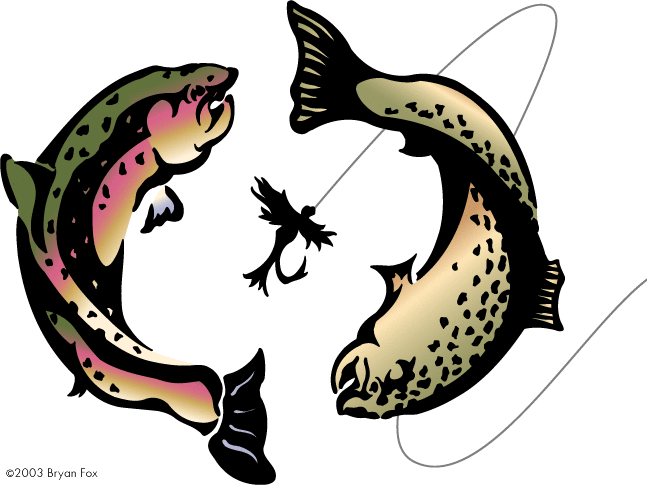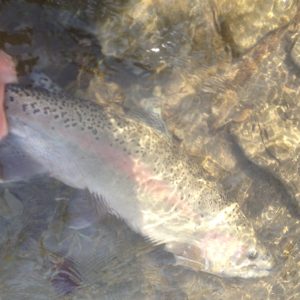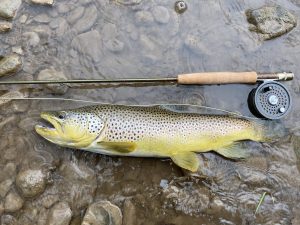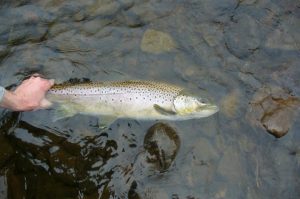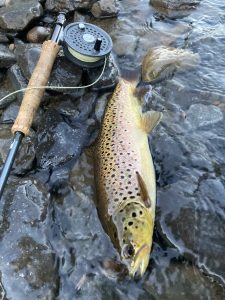NICE RAINBOW brings a smile. Matt landed this nice female rainbow using a #8 Reddish Brown Hare’s Ear nymph on April 11th, 2001 at about 1:00pm. It was 27 inches and weighed in at over 7 pounds. He immediately released it saying “She will lay eggs this year and come back next year again to help create more of these beautiful fish.”
-“Herb Chapple”
Before steelhead were established in Lake Ontario and its tributary system in the late 1960’s; rainbow trout were introduced into the Finger Lakes tributary system. Stocking and management established substantial runs by the 1950’s and runs still exist today.
There are many tributaries throughout the Finger Lakes region that receive runs of rainbow trout. Fish will start to run in the fall and continue to enter the creeks during late winter thawing periods and some will enter as spring progresses. When water temperatures start to rise, spawning will commence. During warm winters many of the early run fish will spawn in the late winter and these fish may return to the lake by the time April arrives. Anglers can intercept these early spawning fish in the lower stretches of the creeks as they drop back to the lakes and hold in the deeper pools. Fish returning to the lake after spawning can really turn on and feed ravenously as they need to build energy depleted during the spawning process. Other years, with a late thaw, there can be fish still arriving in April, and can often be seen moving upstream or darting up a riffle, well into April. With the right timing Finger Lakes tributaries offer excellent opportunities to fly fish for some beautiful Rainbows through April into May. Most range from 2-5 pounds, but some tributaries will draw an occasional 8-10-pound giants that some old timers refer to as “knot testers.”
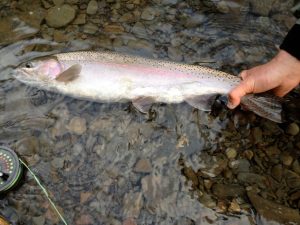
Many Finger Lakes tributaries that receive runs of rainbow trout are small and are often lined with trees and bushes. When fly fishing these smaller streams long casts are often not a necessity, making roll casting critical. An 8 1/2 to 10 foot, five to seven weight rod and a floating fly line is a good outfit for the smaller creeks. Developing creative casting techniques and being aware of obstructions within your casting area are necessary when fishing smaller creeks. One cast I have used frequently in the smaller waters, is to use the resistance cast or flip. This is a very simple cast and uses the resistance of the water to load the rod. This cast starts by resting some fly line in the water downstream of where you are and then perform one hard casting stoke to flick the line upstream a short distance to a target ahead of where you want the fly to drift or swim. This technique limits false casts and motion, which can spook fish on smaller tributaries and will also avoid back-casts which can hit overhanging branches, trees or bushes. Leader length and tippet diameter is determined by water clarity. During high off color water conditions a short leader (7-8 feet) and 3 feet of six or eight pound tippet can be used because the sight distance of the fish is much shorter and they will not be spooked by the leader. As the creeks clear, I typically lengthen the leader and reduce tippet diameter when dead drifting flies or switch to swinging flies which is a technique that always presents the fly with the leader upstream of the fly. These fish can be leader shy and spooky during clear water situations. Four-pound test can help with a natural presentation when fishing a nymph pattern during low clear water conditions. A combination of an eight to nine foot leader and a three feet of tippet will give sufficient separation between the fly line and fly . Bead head or weighted nymphs help get the fly down. A small tin split shot on the leader or attached to the a tag left at the tippet to leader connection can also aid in sinking the fly. I like to avoid the use of heavy split shot, and like to stick with small sizes, especially during low clear water conditions as losing flies to the river bed can be frustrating. When the rainbows are biting they will rise up to take a drifting nymph or move to take a swinging fly which is much more satisfying than dredging the bottom and potentially hooking a resting fish.
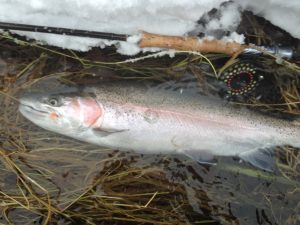
Coming from the security of a deep lake, these fish are very wary and easily spooked when they move into a small tributary. Angler pressure combined with the natural instincts of fish to avoid predators will drive them into cover, so I always use caution when approaching the creek-side keeping an eye out for fish and I always wear a nice pair of polarized sunglasses to aid in sighting fish as well as help to see the stream bottom . Good places to find lake run rainbows are, in deep holes, undercut banks, log -jams, around boulders, in plunge pools, or some heavy riffle water with a little depth.
Small to medium sized nymphs are one effective way to entice Finger Lakes rainbows into biting a fly. Some good patterns to try are small bead-head nymphs, hare body nymphs, and wet flies.
Pheasant Tail Wet
Hook: Nymph 8-14
Thread: olive 8/0
Tail: Pheasant tail fibers
Abdomen: Pheasant Tail fibers
Rib: Fine copper wire
Thorax: Peacock herl
Legs: Hungarian partridge (one or two turns)
Squirrel Hair Nymph
Hook: Nymph 8-12
Thread: Olive 8/0
Tail: Gray, dyed olive or Black squirrel fur
Abdomen: Gray squirrel fur
Rib: Peacock Krystal Flash
Thorax: Same as abdomen Squirrel Fur (teased out)
Wing Case: Peacock herl
Bead Head Olive Wet Fly
Hook: Nymph 6-14
Thread: olive 8/0
Tail: Olive Hare’s mask
Abdomen: Olive hare’s mask
Rib: Fine gold wire
Thorax: Peacock herl
Legs: Hungarian partridge (one or two turns)
Head: Gold Bead
Peacock herl has a natural iridescence and seems to increase the effectiveness of any fly pattern.
The Finger Lakes region has excellent opportunities to challenge the fly-fisherman in search of powerful lake-run rainbow trout.
